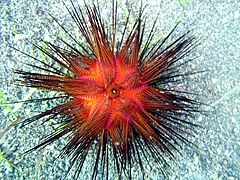You are here
Echinodermata
Diadematidae
EOL Text
Barcode of Life Data Systems (BOLD) Stats
Specimen Records:139
Specimens with Sequences:94
Specimens with Barcodes:87
Species:18
Species With Barcodes:18
Public Records:24
Public Species:12
Public BINs:9
Diadematidae is a family of sea urchins. The test is either rigid or flexible and the spines are long and hollow.[2]
- Astropyga (Gray, 1825)
- Astropyga radiata (Leske, 1778), extant
- Astropyga pulvinata (Lamarck, 1816), extant
- Astropyga magnifica (Clark, 1934), extant
- Centrostephanus (Peters, 1855)
- Centrostephanus asteriscus (Agassiz & Clark, 1907), extant
- Centrostephanus coronatus (Verrill, 1867), extant
- Centrostephanus fragile (Wiltshire in Wright, 1882), Santonian, Maastrichtian, Danian
- Centrostephanus longispinus (Philippi, 1845), extant
- Centrostephanus nitidus (Koehler[disambiguation needed], 1927), extant
- Centrostephanus rodgersii (Agassiz, 1863), extant[3]
- Chaetodiadema (Mortensen, 1903)
- Chaetodiadema granulatum (Mortensen, 1903), extant
- Chaetodiadema keiense (Mortensen, 1903), extant
- Chaetodiadema tuberculatum (Clark, 1909), extant
- Diadema (Humpfreys, 1797)
- Diadema palmeri (Baker, 1967), extant
- Diadema savignyi (Michelin[disambiguation needed], 1845), extant
- Diadema setosum (Leske, 1778), extant
- Diadema antillarum (Philippi, 1845), extant
- Diadema paucispinum (Agassiz, 1863), extant
- Diadema mexicanum (Agassiz, 1863), extant
- Diadema ascensionis (Mortensen, 1909), extant
- Echinodiadema (Verrill, 1867)
- Echinodiadema coronata (Verrill, 1867), extant
- Echinothrix (Peters, 1853)
- Echinothrix calamaris (Pallas, 1774), extant
- Echinothrix diadema (Linnaeus, 1758), extant
- Eodiadema, Lower Jurassic
- Eremopyga (Agassiz & Clark, 1908)
- Eremopyga denudata (De Meijere, 1904), extant
- Goniodiadema (Mortensen, 1939)
- Goniodiadema mauritiense (Mortensen, 1939), extant
- Kamptosoma (Mortensen, 1903), extant
- Palaeodiadema (Pomel, 1887), Santonian, Maastrichtian, Danian
- Pedinothuria (Louis[disambiguation needed], 1897)
- Pedinothuria cidaroides (Gregory, 1897), Callovian, Oxfordian
- Trichodiadema (Agassiz, 1863)
- Trichodiadema rodgersii (Agassiz, 1863), extant
References[edit]
- ^ "Diadematidae". Integrated Taxonomic Information System.
- ^ Maran, Vincent (2010-11-11). "Astropyga radiata (Leske, 1778)". DORIS (in French). Retrieved 2013-01-22.
- ^ "Black Sea Urchin". Museum Victoria. Retrieved 2011-05-13.
| Wikimedia Commons has media related to Diadematidae. |
 |
This article about a sea urchin is a stub. You can help Wikipedia by expanding it. |
| License | http://creativecommons.org/licenses/by-sa/3.0/ |
| Rights holder/Author | Wikipedia |
| Source | http://en.wikipedia.org/w/index.php?title=Diadematidae&oldid=627181001 |
recent & fossil
| License | http://creativecommons.org/licenses/by/4.0/ |
| Rights holder/Author | This work is licensed under a Creative Commons Attribution-Share Alike 4.0 License |
| Source | http://www.marinespecies.org/aphia.php?p=taxdetails&id=123163 |
The family Diadematidae has around 30 extant species, including some of the most common tropical sea urchins species (Diadema antillarum, Diadema setosum, Astropyga radiata...).
These are big regular sea urchins, with hollow and usually very long spines, some of them being venomous (but not dangerous for humains). Some are bright colored (especially red or blue), but others are dark, sometimes with ornamental patterns called iridophores (especially Astropyga and Diadema).
One of their most obvious characteristic is to have an "anal papilla" (or "anal cone") on the top of the test : it can be very obvious in some species (Echinothrix calamaris, Diadema setosum) or nearly hidden (Echinothrix diadema, Centrostephanus longispinus).
The most common genera found at diving depths are Diadema, Echinothrix, Astropyga and Centrostephanus ; other genera like Chaetodiadema are found only in deep waters.
Most of them inhabit tropical waters of the indo-pacific.
Among their skelettal characteristics, they have trigeminate ambulacra, with perforated tubercles, almost always crenulate.
| License | http://creativecommons.org/licenses/by/3.0/ |
| Rights holder/Author | Frédéric Ducarme, Frédéric Ducarme |
| Source | No source database. |



